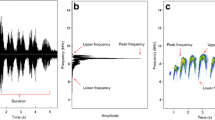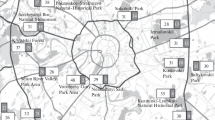Abstract
During a short field trip to the Special Reserve of Anjanaharibe-Sud in northeastern Madagascar, data concerning pelage coloration, behavior (especially vocalization), and ecology of indris were collected. Anjanaharibe-Sud is the northernmost locality of indri distribution. In comparison to the better-known indris from the southern part of their distribution, the indris in this region show different pelage coloration. Several types of loud vocalizations are analyzed, based on a small sample of tape recordings. Their song structure is more complicated than previously reported, containing distinct sequences of duetting. Data on behavior and ecology were collected by interviewing guides and local inhabitants. Some information contrasts with reports on the more southern indri populations. The conservation status of indris in Anjanaharibe-Sud and the future of the reserve are outlined.
Similar content being viewed by others
References
Attenborough, D., and Blanchard, G. (1969).Ghost at the End of the Earth—A New Quest for Lemurs, Film, BBC TV, UK, 45 min.
Attenborough, D., and Parsons, C. (1980).Das Leben auf unserer Erde—Das Leben in den Bäumen, Film, BBC TV, UK, 45 min.
Buettner-Janusch, J., and Tattersall, I. (1985). An annotated catalogue of Malagasy primates (Families Lemuridae, Indriidae, Daubentoniidae, Megaladapidae, Cheirogaleidae) in the collections of the American Museum of Natural History.Am. Mus. Novit. (N.Y.) No. 2834 (Nov. 12): 1–45.
Freemann, D. (1978).Affen in Farbe, Südwest Verlag, München. (German edition ofThe Love of Monkeys and Apes, Octopus Books, London, 1977).
Geissmann, T. (1984). Inheritance of song parameters in the gibbon song, analyzed in 2 hybrid gibbons (Hylobates pileatus × H. lar).Folia Primatol. 42: 216–235.
Geissmann, T. (1993).Evolution of Communication in Gibbons (Hylobatidae). Ph.D. thesis, Anthropology Institute, Philosoph. Faculty II, Zürich University, Zürich.
Haimoff, E. H. (1984). Acoustic and organizational features of gibbon songs. In Preuschoft, H., Chivers, D. J., Brockelman, W. Y., and Creel, N. (eds.),The Lesser Apes. Evolutionary and Behavioral Biology, Edinburgh University Press, Edinburgh, pp. 333–353.
Haimoff, E. H. (1986). Convergence in the duetting of monogamous Old World monkeys.J. Hum. Evol. 15: 51–59.
Harcourt, C., and Thornback, J. (1990).Lemurs of Madagascar and the Comoros. The IUCN Red Data Book, IUCN (International Union for Conservation of Nature and Natural Resources), Gland, Switzerland, and Cambridge, UK.
Herzog and Wothe (1989).Urwaldgeister auf Madagaskar—Eine Expedition ins Reich der Lemuren, Film, ZDF, Germany, 45 min.
MacKinnon, J., MacKinnon, K., Child, G., and Thorsell, J. (1986).Managing Protected Areas in the Tropics, IUCN (International Union for Conservation of Nature and Natural Resources), Gland, Switzerland, and Cambridge, UK.
Marshall, J. T., and Marshall, E. R. (1976). Gibbons and their territorial songs.Science 193: 235–237.
Marshall, J., and Sugardjito, J. (1986). Gibbon systematics. In Swindler, D. R., and Erwin, J. (eds.),Comparative Primate Biology, Vol. 1. Systematics, Evolution, and Anatomy, Alan R. Liss, New York, pp. 137–185.
Milne-Edwards, A., and Grandidier, A. (1875a). Histoire naturelle des mammifères, Tome I, Texte I. In Grandidier, A. (ed.),Histoire physique, naturelle et politique de Madagascar, Vol. 6. Les indrisinés, Imprimerie Nationale, Paris.
Milne-Edwards, A., and Grandidier, A. (1875b). Histoire naturelle des mammifères, Tome IV, Atlas I. In Grandidier, A. (ed.),Histoire physique, naturelle et politique de Madagascar, Vol. 9, Imprimerie Nationale, Paris.
Nicoll, M. E., and Langrand, O. (1989).Madagascar: Revue de la conservation et des aires protégées, WWF, Gland, Switzerland.
Oliver, W. L. R., and O'Connor, S. M. (1980). Circadian distribution ofIndri indri group vocalizations: A short period sampling at two study sites near Perinet, eastern Madagascar.Dodo J. Jersey Wildl. Preserv. Trust 17: 19–27.
Paulian, R. (1981). Les mammifères: Vestiges d'un monde disparu. In Oberlé, P. (ed.),Madagascar—un sanctuaire de la nature, KINTANA, Riedisheim, France, pp. 75–94.
Petter, J.-J. (1962). Recherches sur l'écologie et l'éthologie des Lémuriens Malgaches.Mém. Mus. Natl. Hist. Nat. Sér. A. Zool. 27 (1): 1–146.
Petter, J.-J., and Charles-Dominique, P. (1979). Vocal communication in prosimians. In Doyle, G. A., and Martin, R. D. (eds.),The Study of Prosimian Behavior, Academic Press, New York, San Francisco, and London, pp. 247–305.
Petter, J.-J., and Peyriéras, A. (1974). A study of the population density and home range ofIndri indri in Madagascar. In Martin, R. D., Doyle, G. A., and Walker, A. C. (eds.),Prosimian Biology, Duckworth, London, pp. 39–48.
Petter, J.-J., Albignac R., and Rumpler, Y. (1977).Faune de Madagascar, Vol. 44. Mammifères Lémuriens (Primates Prosimiens), ORSTOM/CNRS, Paris.
Pollock, J. I. (1975a). Field observations onIndri indri: A preliminary report. In Tattersall, I., and Sussman, R. W. (eds.),Lemur Biology, Plenum Press, New York and London, pp. 287–311.
Pollock, J. I. (1975b).Social Behavior and Ecology of Indri indri, Ph.D. thesis, University of London, London.
Pollock, J. I. (1977). The ecology and sociology of feeding inIndri indri. In Clutton-Brock (ed.),Primate Ecology. Feeding and Ranging Behavior of Lemurs, Monkeys and Apes, Academic Press, London, pp. 37–69.
Pollock, J. I. (1979). Female dominance inIndri indri.Folia Primatol. 31: 143–164.
Pollock, J. I. (1986). The song of the Indris (Indri indri; Primates: Lemuroidea): Natural history, form, and function.Int. J. Primatol. 7: 225–267.
Salisbury, M., Newman, O., and Curl, D. (1988).Madagaskar—Land der Lemuren Film, BBC Bristol and WNET 13 New York, NDR, Germany.
Schmidt, R., Radin, J., and Brodie, J. (1989).MacRecorder ® User's Guide, Farallon Computing, Emeryville.
Schultz, A. H. (1972).Die Primaten, Edition Rencontre, Lausanne.
Schwarz, E. (1931). A revision of the genera and species of Madagascar Lemuridae.Proc. Zool. Soc. Lond. 1931: 399–428.
Sonnerat, M. (1782).Voyage aux Indes orientales et à la Chine, Froulé, Paris.
Tattersall, I. (1982).The Primates of Madagascar, Columbia University Press, New York.
Thorpe, W. H. (1961).Bird-Song. The Biology of Vocal Communication and Expression in Birds, Cambridge University Press, Cambridge.
United States Board on Geographic Names (1955).Official Standard Names Gazetteer No. 2: Madagascar, Reunion and the Comoro Islands, Department of the Interior, Washington, DC.
Wickler, W. (1974). Duette und Paarbindung bei Tieren.Mitt. Max-Planck-Ges. 1974: 237–252.
Author information
Authors and Affiliations
Rights and permissions
About this article
Cite this article
Thalmann, U., Geissmann, T., Simona, A. et al. The indris of Anjanaharibe-Sud, northeastern Madagascar. International Journal of Primatology 14, 357–381 (1993). https://doi.org/10.1007/BF02192772
Received:
Accepted:
Issue Date:
DOI: https://doi.org/10.1007/BF02192772




